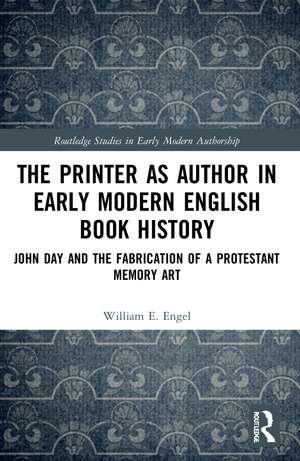The Printer as Author in Early Modern English Book History: John Day and the Fabrication of a Protestant Memory Art: Routledge Studies in Early Modern Authorship
Autor William E. Engelen Limba Engleză Paperback – 29 ian 2024
| Toate formatele și edițiile | Preț | Express |
|---|---|---|
| Paperback (1) | 309.99 lei 6-8 săpt. | |
| Taylor & Francis – 29 ian 2024 | 309.99 lei 6-8 săpt. | |
| Hardback (1) | 1001.24 lei 6-8 săpt. | |
| Taylor & Francis – 6 mai 2022 | 1001.24 lei 6-8 săpt. |
Preț: 309.99 lei
Nou
Puncte Express: 465
Preț estimativ în valută:
59.31€ • 61.94$ • 48.98£
59.31€ • 61.94$ • 48.98£
Carte tipărită la comandă
Livrare economică 15-29 aprilie
Preluare comenzi: 021 569.72.76
Specificații
ISBN-13: 9781032223988
ISBN-10: 1032223987
Pagini: 232
Ilustrații: 66
Dimensiuni: 152 x 229 x 13 mm
Greutate: 0.32 kg
Ediția:1
Editura: Taylor & Francis
Colecția Routledge
Seria Routledge Studies in Early Modern Authorship
Locul publicării:Oxford, United Kingdom
ISBN-10: 1032223987
Pagini: 232
Ilustrații: 66
Dimensiuni: 152 x 229 x 13 mm
Greutate: 0.32 kg
Ediția:1
Editura: Taylor & Francis
Colecția Routledge
Seria Routledge Studies in Early Modern Authorship
Locul publicării:Oxford, United Kingdom
Public țintă
Postgraduate and UndergraduateNotă biografică
William E. Engelis the Nick B. Williams Professor of English at The University of the South: Sewanee. He has published seven books on literary history and applied emblematics, two previously with Routledge, Chiastic Designs (2016) and Early Modern Poetics (2016), and has contributed chapters to several Routledge volumes, including The Birth and Death of the Author (2020), The Routledge Handbook of Shakespeare and Memory (2017), and Forgetting in Early Modern English Literature and Culture (2004).
Cuprins
Introduction: Incarnating Ideas1 The deluxe design of The Cosmographical Glass (1559)
2 Renovating the Catechism (1553) and Metrical Psalms (1562)
3 The grand enterprise of Foxe’s Book of Martyrs (1563)
4 Underwriting England’s first Protestant emblem book (1568)
5 The compelling visuality of Queen Elizabeth’s Prayer Book (1569, 1578)
Conclusion: Making History
2 Renovating the Catechism (1553) and Metrical Psalms (1562)
3 The grand enterprise of Foxe’s Book of Martyrs (1563)
4 Underwriting England’s first Protestant emblem book (1568)
5 The compelling visuality of Queen Elizabeth’s Prayer Book (1569, 1578)
Conclusion: Making History
Recenzii
"Engel makes a compelling, highly erudite intervention, using the lifework of John Day.... Engel's mastery of the scholarship of early modern book history, together with the other scholarly disciplines that he imaginatively brings to bear, is evidenced by the extensive bibliographies at the end of each chapter. Most insightful, however, are the sustained material and iconographic analyses of Engel's primary sources.... Engel's arguments are lucid and carefully presented." --Renaissance Studies 36.4 (Sept 2022)
"...provides valuable insights into the practical and material side of collective book production in early modern England. [...] Engel's book proves to be a highly impressive and valuable contribution to the fields of authorship and material studies." --Anglistik 34.3 (2023): 256-57.
“In this engaging journey through the career of the sixteenth-century English printer John Day, William E. Engel makes the case for Day as an ingenious craftsman of Tudor cultural memory. [...] Engel’s analysis is at its best in showcasing Day’s typographical and iconographical creativity, or the ‘mental machinery’ (p. 95) of his Protestant print. [...] The Printer as Author brings the creative hub of Day’s printing house to life as a force for the authorization and reformation of the book.” –Modern Language Review 119 (April 2024): 260-61
"...provides valuable insights into the practical and material side of collective book production in early modern England. [...] Engel's book proves to be a highly impressive and valuable contribution to the fields of authorship and material studies." --Anglistik 34.3 (2023): 256-57.
“In this engaging journey through the career of the sixteenth-century English printer John Day, William E. Engel makes the case for Day as an ingenious craftsman of Tudor cultural memory. [...] Engel’s analysis is at its best in showcasing Day’s typographical and iconographical creativity, or the ‘mental machinery’ (p. 95) of his Protestant print. [...] The Printer as Author brings the creative hub of Day’s printing house to life as a force for the authorization and reformation of the book.” –Modern Language Review 119 (April 2024): 260-61
Descriere
This is the first book to demonstrate how mnemotechnical cultural commonplaces can be used to account for the look, style, and authorized content of some of the most influential books produced in early modern Britain.


